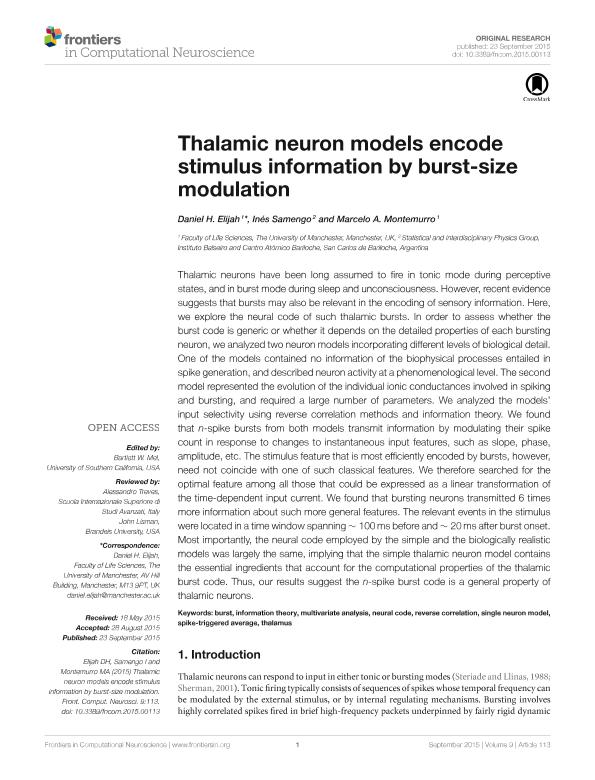Mostrar el registro sencillo del ítem
dc.contributor.author
Elijah, Daniel H.
dc.contributor.author
Samengo, Ines

dc.contributor.author
Montemurro, Marcelo Alejandro

dc.date.available
2018-08-10T14:43:48Z
dc.date.issued
2015-09
dc.identifier.citation
Elijah, Daniel H.; Samengo, Ines; Montemurro, Marcelo Alejandro; Thalamic neuron models encode stimulus information by burst-size modulation; Frontiers Research Foundation; Frontiers in Computational Neuroscience; 9; SEP; 9-2015; 1-16
dc.identifier.issn
1662-5188
dc.identifier.uri
http://hdl.handle.net/11336/54961
dc.description.abstract
Thalamic neurons have been long assumed to fire in tonic mode during perceptive states, and in burst mode during sleep and unconsciousness. However, recent evidence suggests that bursts may also be relevant in the encoding of sensory information. Here, we explore the neural code of such thalamic bursts. In order to assess whether the burst code is generic or whether it depends on the detailed properties of each bursting neuron, we analyzed two neuron models incorporating different levels of biological detail. One of the models contained no information of the biophysical processes entailed in spike generation, and described neuron activity at a phenomenological level. The second model represented the evolution of the individual ionic conductances involved in spiking and bursting, and required a large number of parameters. We analyzed the models' input selectivity using reverse correlation methods and information theory. We found that n-spike bursts from both models transmit information by modulating their spike count in response to changes to instantaneous input features, such as slope, phase, amplitude, etc. The stimulus feature that is most efficiently encoded by bursts, however, need not coincide with one of such classical features. We therefore searched for the optimal feature among all those that could be expressed as a linear transformation of the time-dependent input current. We found that bursting neurons transmitted 6 times more information about such more general features. The relevant events in the stimulus were located in a time window spanning 〜100 ms before and 〜20 ms after burst onset. Most importantly, the neural code employed by the simple and the biologically realistic models was largely the same, implying that the simple thalamic neuron model contains the essential ingredients that account for the computational properties of the thalamic burst code. Thus, our results suggest the n-spike burst code is a general property of thalamic neurons.
dc.format
application/pdf
dc.language.iso
eng
dc.publisher
Frontiers Research Foundation
dc.rights
info:eu-repo/semantics/openAccess
dc.rights.uri
https://creativecommons.org/licenses/by-nc-sa/2.5/ar/
dc.subject
Burst
dc.subject
Information Theory
dc.subject
Multivariate Analysis
dc.subject
Neural Code
dc.subject
Reverse Correlation
dc.subject
Single Neuron Model
dc.subject
Spike-Triggered Average
dc.subject
Thalamus
dc.subject.classification
Otras Ciencias Biológicas

dc.subject.classification
Ciencias Biológicas

dc.subject.classification
CIENCIAS NATURALES Y EXACTAS

dc.title
Thalamic neuron models encode stimulus information by burst-size modulation
dc.type
info:eu-repo/semantics/article
dc.type
info:ar-repo/semantics/artículo
dc.type
info:eu-repo/semantics/publishedVersion
dc.date.updated
2018-08-08T14:13:36Z
dc.journal.volume
9
dc.journal.number
SEP
dc.journal.pagination
1-16
dc.journal.pais
Suiza

dc.journal.ciudad
Lausanne
dc.description.fil
Fil: Elijah, Daniel H.. University of Manchester; Reino Unido
dc.description.fil
Fil: Samengo, Ines. Consejo Nacional de Investigaciones Científicas y Técnicas; Argentina. Comisión Nacional de Energía Atómica. Gerencia del Area de Investigación y Aplicaciones No Nucleares. Gerencia de Física (Centro Atómico Bariloche); Argentina
dc.description.fil
Fil: Montemurro, Marcelo Alejandro. University of Manchester; Reino Unido
dc.journal.title
Frontiers in Computational Neuroscience
dc.relation.alternativeid
info:eu-repo/semantics/altIdentifier/doi/https://dx.doi.org/10.3389/fncom.2015.00113
dc.relation.alternativeid
info:eu-repo/semantics/altIdentifier/url/https://www.frontiersin.org/articles/10.3389/fncom.2015.00113/full
Archivos asociados
